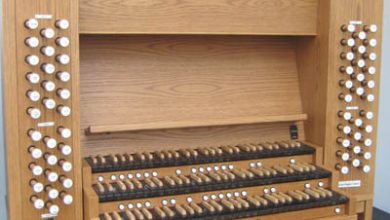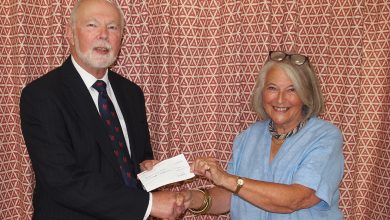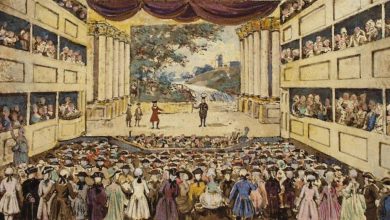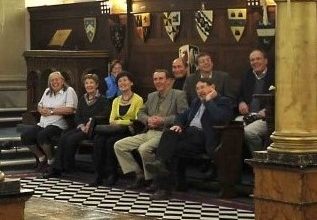New Altar Dedication for Jubilee Rose Croix
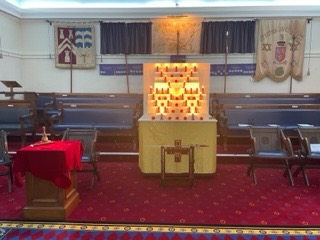
Friday 20th May 2022 saw the dedication of a new altar for the Jubilee Chapter 838 Rose Croix at the Keynsham Masonic Centre. The dedication was conducted by the Most Illustrious Brother Rev Dr Simon Thorn 33° Grand Prior, accompanied by Illustrious Brother Alan Brumwell 32°, Deputy Grand Director of Ceremonies.
The building of the new altar was made possible by a very generous bequest by the late, Excellent & Perfect Prince Tony Allan. The curtains that surround the base of the altar were repurposed to fit by Barbara Godfrey, our Recorders late wife. We are eternally thankful to them both.
The building of the Altar was commissioned in 2019, to be built by a much-respected Mason, WBro David Lyons. Many hours were spent on the construction with minor changes being fluid throughout. The altar was completed and delivered by David on the 14 June 2021
The dedication was specially written and was a ‘one off’ as it did not represent any known Rose Croix ritual. It was a special evening and was rounded off by a talk by Allan Rosengren the Most Eminent Grand Superintendent of the Camp of Baldwyn and Illustrious Brother Alan Vaughan on the links with the ancient and accepted rite of Baldwyn and their use of the apron and sword.
We also received a presentation by our own Prelate Illustrious Brother Stuart Hadler on Keynsham Masonic Hall and the Plaques, a copy of which is included below.
The evening was rounded off with a wonderful meal in excellent company. In conclusion we would like to thank Supreme Grand Council for their attendance and help during the preparations for this wonderful evening, to the speakers for their presentations and to all the visiting Sovereigns, Inspectors General and Princes that attended.
A Brief History of Keynsham Masonic Hall and the set of plaques in the Temple.
A Talk on the occasion of the dedication of the new Altar
Jubilee Rose Croix Chapter No. 838
Friday 20th May 2022
Introduction
The most interesting talk by the Most Eminent Grand Superintendent of the Camp of Baldwyn, Allan Rosengren and Ill. Bro Alan Vaughan links logically with an outline of the development of Freemasonry here in Keynsham and the historical and current links with the Province of Bristol.
Origins
Freemasonry’s earliest known link with Keynsham dates back to the 1860’s with the consecration of the Royal Albert Edward Lodge No. 906 at the Lamb & Lark Hotel, Keynsham on 29th May 1862. This lodge very shortly removed to Bath where it continues to meet.
Some 6 or 7 years later, 11 brethren were moved to form a lodge to meet in the village of Brislington, which is approximately midway between here and the centre of Bristol.
So why Brislington and what is the Bristol connection?
Seven of the eleven founders were prominent Bristol masons, mostly from Beaufort Lodge. They were desirous of forming a summer vacation lodge (meeting monthly from May to August) to continue their freemasonry away from the City.
Principal among them was Samuel Bryant, a surgeon, resident of Brislington and sometime Provincial Prior and Deputy PGM of the Mark Province of Bristol. He, one assumes, identified the White Hart Hotel as a suitable venue that was able to provide a meeting room and a convivial meal. In later years it also offered the bonus of a game of bowls on the green behind the hotel.
Other Founders included Edward Inskip a future PGSec of Bristol and a Past JGW of Somerset; Samuel Taylor, Deputy Grand Supt of the Camp of Baldwyn and Provincial Prior and James Bramble a future PGM of Bristol and Grand Superintendent of the Camp of Baldwyn.
A Somerset founder was Francis George Irwin who lived close to Brislington. A military man, active in many masonic orders. Irwin was instrumental in founding the William de Irwin Rose Croix Chapter in Weston s Mare in 1870. He later became Deputy PGM of the Mark Province of Somerset.
Having been sponsored by the Royal Edward Lodge in November 1869, Vale of Brislington Lodge No. 1296 was consecrated at the White Hart Hotel on 15th March 1870 and remained there for 83 years.
Thus began the exception to the Bristol Craft ritual being practised only in that Province first at Brislington and later at Keynsham.
The ten petitioners of the St Keyna Lodge No. 1833 were mostly Keynsham residents. There were nineteen Founders most of whom were either Bath or Bristol members. The Lodge was sponsored by Vale of Brislington Lodge and consecrated in 1879. It too works the Bristol ritual. The Lodge met for 61 years in the less than salubrious Lamb and Lark Public House in Keynsham.
Incidentally, St Keyna was an early Christian saint, daughter of a Welsh prince, who lived a hermit’s existence in a local wood. The wood was reputedly infested with snakes which St Keyna by her prayers turned to stone. It is no coincidence that ammonite fossils are commonly found in the local stone. Evidently the name of Keynsham derives from this Saint.
Abbey Lodge (4491) was consecrated in 1922. It too adopted the Bristol working and is a grand-daughter of Vale of Brislington Lodge.
There is sometimes competitive banter as to whether the Vale of Brislington ritual is closer to the original working than that currently practiced in Bristol. It would, however, be insensitive to pursue that further this evening! What is evident from the records is that Bristol working at Keynsham was a matter of concern, if not tension between both provinces and with the lodges themselves. On one occasion a Somerset PGM, unhappy with the use of the Bristol working, attended Vale of Brislington lodge and with very little notice, took the gavel and proceeded to conduct an emulation installation ceremony and not without a little confusion and upset. Suffice to say that today peace and harmony reign and we are delighted to have this wonderful ritual practiced here.
This building
In 1939, after many years of searching for a new location, St Keyna Lodge purchased this site and designed the Hall. Despite the War, construction proceeded. The hall was first used on 26th August 1940 and was consecrated in 1946.
A further 7 craft lodges have met here since. In each case use of the Bristol working was either not sought or not approved.
It is, I think, of interest to note and perhaps speculate on the fact that whilst the Mark degree came to this locality in 1870 and Royal Ark Mariner in 1873 other orders did not meet here until the arrival of Secret Monitor in 1951 followed by Rose Croix in 1969 and KT in 1975. Surprisingly a Royal Arch Chapter did not exist here until 1980. Keynsham masons with an interest in these orders presumably travelled to Bath, Bristol and other centres to enjoy these orders or elsewise had a limited masonic experience.
There are now 19 lodges or chapters meeting at Keynsham including Keynsham Rose Croix 678 (1969) which now meets at a local Golf Club and Jubilee Rose which was consecrated here in 1978.
A brief contextual word about the Ancient and Accepted Rite in Somerset.
The first recorded presence of the Rose Croix is in 1852 when a warrant was granted for St Peter and Paul Chapter to meet in Bath. Its first MWS, Charles John Vigne, was later to become Sovereign Grand Commander of the Order. By 1870 there were more Rose Croix Chapters in Somerset than in any other English county. Precisely 4 with 2 meeting in Bath and one in Taunton and one in Weston s Mare. The latter instigated by Francis Irvin as mentioned earlier. No more Chapters were consecrated until 1955. A gap of 85 years. Now the District comprises 20 chapters spread throughout Somerset.
The Plaques
I have been asked to say a little about the 10 plaster plaques that are arranged around the lodge room.
As you have probably worked out for yourselves, they depict scenes from the Third Degree traditional history that features in the Emulation and other Craft rituals.
The account commences with the 15 conspirators depicted on the south wall and moves clockwise around the walls culminating with the raising in the east and finally in the south east with the discovery of the three villains and their sentence to death by King Solomon.
My attempts to establish the origin of the plaques and how we have a set in Keynsham have not been successful. A history of St Keyna Lodge in 1965 refers briefly to the panels and records that they were tinted and gilded by W Bro Cecil Ewins.
The ten plaques sit naturally within the wall frieze which suggests the plaques were installed at a point when the final rendering and decoration of the lodge room was undertaken maybe as much as 10 years or more after the original construction.
There is at least one other set in existence, at Caversham in Berkshire. This set is unpainted. Vague memories recall that there are 2 or 3 others part or full sets elsewhere.
Suffice to say the plaques are exceedingly rare and an impressive addition to the lodge room and indeed to the third degree ceremony when the candidate is escorted around the room whilst the history is recounted.
Jubilee Rose Croix meet at Keynsham on the 3rd Friday in the months of February, May and September. Visitors from other Chapters very welcome and new members are encouraged, that if they wish to join this wonderful Christian order, to contact our recorder, Peter Godfrey on peter.h.godfrey@googlemail.com

